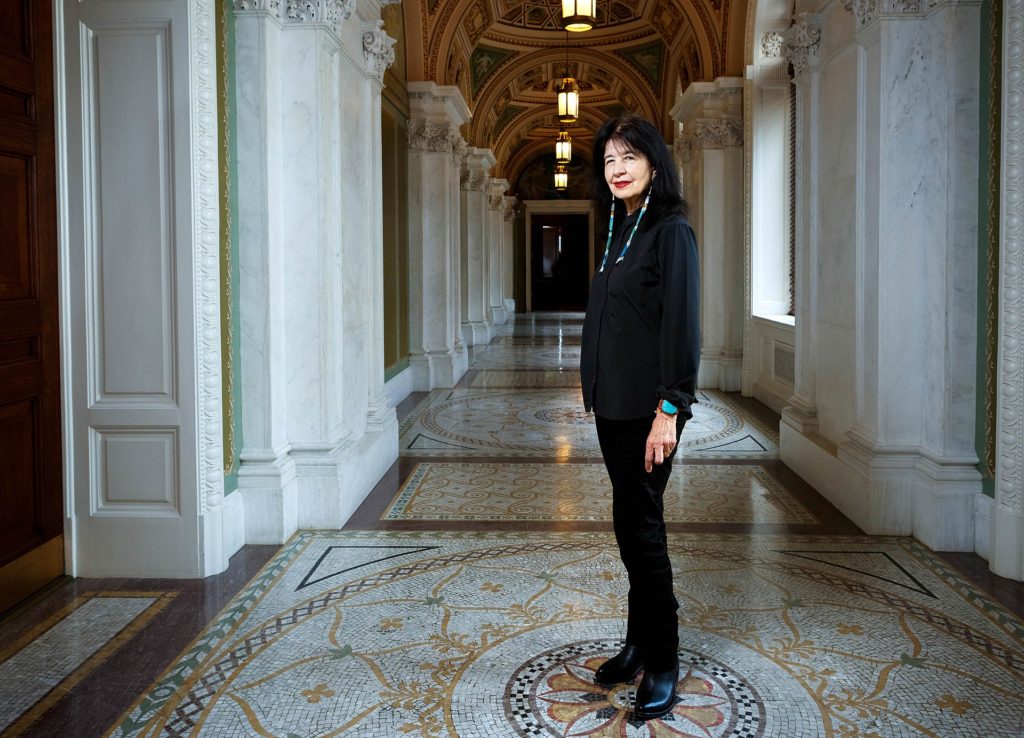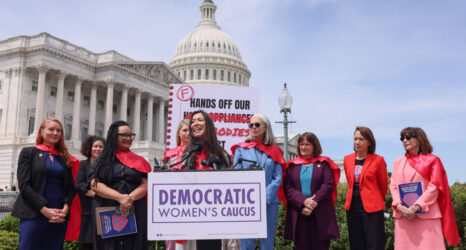When Joy Harjo was in the first grade, she drew a ghost green. Her color choice challenged the collective memory and caused a classroom uproar. That marked one moment in which she learned about the power of imagery—and began her life-long journey of using art to re-examine the truths we cling to about history and ourselves.
Born in Tulsa, Oklahoma, in 1951, Harjo turned to writing to cope with an abusive childhood, teenage pregnancy, poverty and the ongoing erasure of Native American people and women. In 1973, poetry became her main creative outlet, and she published her first poetry collection, The Last Song. In a career spanning four decades, she has since published seven books of poetry, two children’s books and a memoir. Her later collections In Mad Love and War and The Woman Who Fell From the Sky won an American Book Award and an Oklahoma Book Arts Award, respectively.
Native American myths and history ground Harjo’s work as a writer, poet and musician who hails from the Muscogee Nation. Her willingness to pen internal and historical pain in lyrical poetry and prose led to her receive a National Endowment of the Arts Creative Writing Fellowship and a Guggenheim Fellowship—and most recently earned her a place in history making when she was named the first Native American Poet Laureate.
The poet and creative visionary spoke with Ms. about the power of poetry and her plans to expand the national conversation in her new post.

Upon being named Poet Laureate, you said: “It is such an honoring for Native people in this country when we’ve been so disappeared and disregarded.” How are you reconciling the history this recognition comes with?
First of all, I’ve learned so much about the Library of Congress—and we need we need to take care of it. We need to continue a library of ideas and learning the history of who we are and where we come from. We need to record all of the struggles in it: the struggles of being women in this country, the struggle of Indigenous peoples and immigrants. All of these stories are the American story.
And the root story, of course, is Indigenous peoples. We’re not just a Native American or a Native person. We’re over 500 different tribal groups. Each tribal nation has its own story. So often Indigenous people have been left out of this story. And Indigenous women have been left out. So right away, the position shifts that for a moment.
That’s what excites me most, is this opportunity to open up the American story to include Indigenous people. We are the root cultures of this tree, but we’ve often been disappeared and disregarded because there’s so much complicated and even twisted history around who we are.
One of the first poems you wrote was “I Give You Back,” or “Fear poem.” So many of our political issues today are rooted in fear—of women’s bodies, of immigrants. Why do you think so many people refuse to release fear?
Well, often fear becomes very familiar. It can become part of everybody. When I say every body I think of our own personal bodies, private bodies. I think of the body politic of indigenous nations, and the body of America.
I’ll never forget a Bolivian Native woman at a conference of Natives from on over the Americas outside of that Quito Ecuador once, she stood up in a meeting of women and said,:“Why does the U.S. call itself America? We are one body, all the way from the top of the hemisphere to Tierra del Fuego.” That always stuck with me.
Also, each person has so many bodies. We carry generations. It’s even proven scientifically about how a woman is carrying her mother, and grandmothers, and then can carries grandchildren. It’s complicated, yet so simple.
A line in your memoir painfully resounds: “Women often turn their anger inward.” How do you begin the process of repurposing anger into motivation or creativity?
I remember being a young woman, and feeling that, if I were to recognize my anger, it would destroy me and everyone else. And I had to put it somewhere.
I put it through weight training through dance, through poetry, through writing. That became a way to at least look so that it does not take you over. Because if it takes you over, then anger is in control. How does that serve you? How does it serve everyone? I’ve learned to sit with it, it’s very difficult to sit with it sometimes. But if you just sit with it, and breathe with it, then you can understand it and find a way to transform it.
For me, writing poetry is a way to transform. It’s been a way to transform fear into something useful, to transform anger into something that might help us move forward together. That’s what poetry has been for me, and a lot of people worldwide.
What made you return to your musical background?
When I was about 14, I was forbidden to sing in the house by my stepfather. Around that time, I had taken a couple years of clarinet at school. I wanted to play saxophone, but the band teacher wouldn’t let the girls play saxophone. And I had so much going on, you know, emotionally, and was just trying to make it through that I didn’t have enough fight to take that on. So I let it go.
And then, years later, when I started writing poetry in my twenties, I always heard music with it. Music is never set far away from poetry. I don’t care, you know, what school write out of or how abstract you are going. It’s always nearby, just as dance is always nearby. But taking up a saxophone doesn’t make the most sense, because I can’t sing or speak. But I love the sound of the saxophone. It’s a voice and it allows me to sing in a way that’s not possible otherwise. It almost allows me to sing poetry in a way that words can’t. In my mind, it all works. It all works together.
I mean, the saxophone taught me to sing. The saxophone has been a healer. I almost died twice in my life from pneumonia. It takes care of my lungs on a very practical level. My grandmother, Naomi Harjo, also played saxophone in Indian Territory, before Oklahoma was a state, and she was a painter and an amazing person.
Healing comes up when you write about nature. You often address the overlaps and differences between Native culture and American culture, and a tension appears when you discuss the environment and the earth. How do you hope the conversation around climate change evolves?
Well, I think it’s central to anything we do. We are the Earth, you know, we are absolutely the Earth. We’re in the midst of a claim that climactic change, I think it’s undeniable; we all have to work together, because we are together. We can either work together to change our relationship with the Earth, or we’re all going down together. It’s that simple.
We have to find a way. Poetry has many uses, you know, and it can transform. We’re all energy and the words are energy. Words go out and make shapes in the air. You can’t always see them. They make patterns and songs and sounds. So is the earth. The earth years has its own voice, and the earth even speaks to us. We may not even know that’s what’s happening.
I really like the line in your newest poem, “American Sunrise”—“forty years later, we still want justice.” You find a way to sound strong, not defeated. How do you stay hopeful?
I don’t think I could live with the alternative, the despair—that doesn’t mean I don’t feel it. That doesn’t mean that I don’t grieve into the night, like so many, we all do. It doesn’t mean I am not concerned about our children and our grandchildren. And they’re all in the old way, in the way that I was.
You know, I’ve had many, many teachers in my life, and a lot of them, the people who know things, are often the older people, and they’ll say: “all the children are our children, all the grandchildren are our children.” When I see them, and I hear their poetry, and I hear them singing, and I watch them create and I watch the creative impulse moving through them and see it in their eyes, I know that we have to continue.
You know, we’re here for the duration. We have to continue, we have to keep going. We have to lift people up with our thoughts, actions, our work.
How do you take care of yourself?
I am trying to remember that right now. I go to my saxophone. I like to be around my grandchildren. I like to be around music. I go to music. I have to unplug and stop thinking and just be.
You get an opportunity to be a teacher of sorts in this new role. How do you plan to help other people find their voices during your time as Poet Laureate?
I haven’t figured out the exact project, but whatever that project is, I want it to be about listening. Poetry is really about listening, and I think if we were to listen, we would definitely hear the earth.
There are trees that sing. There are plants that talk. There is all of this communication going on. The wind, it’s all there. We all have the capability to hear it. When you hold a tree in the poem, or there are stones in your poem, or seasons, they help you stop and listen and remember we are part of all of this.
Any project will have poetry central—but how can we speak across the line? How can we speak about the unspeakable? How can we speak about the unspeakable about, you know, these children? To me, that’s one of the worst crimes, is the abuse of children.
How do we use poetry to make links and connections, so people listen and there is no more cruelty in the world? We all have a small part.





